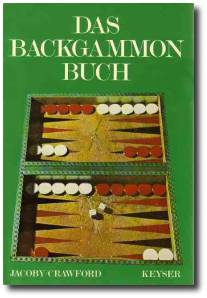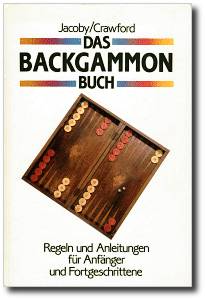 |
|
|

| Backgammon-Bibliographie | ||||
| Autoren (Name, Vorname) | Jacoby, Oswald | |||
| Crawford, John | ||||
| Titel | Das Backgammon Buch | |||
| Untertitel | Regeln und Anleitungen für Anfänger und Fortgeschrittene | |||
| Cover |


|
|||
| Jahr | 1974 | |||
| Seiten | 257 | |||
| Verlag | Keysersche Verlagsbuchhandlung bzw. Pawlak | |||
| Bindung | Hardcover mit Schutzumschlag (Keyser) bzw. ohne Schutzumschlag (Pawlak) | |||
| ISBN | 3-87405-091-2 (Keyser) bzw. 3-88199-351-7 (Pawlak) | |||
| Sprache | deutsch | |||
| Anmerkungen | 1. Ein Klassiker und ein Muss für jede wohlsortierte Backgammon Bibliothek.
2. Die deutsche Übersetzung von "The Backgammon Book". Übersetzt von Jens-Schmidt-Prange und Suzanne Gangloff (historische Einleitung). 3. Das Copyright für die deutsche Ausgabe liegt bei der Keyserschen Verlagsbuchhandlung GmbH, München. Öfter gedruckt jedoch wurde die Ausgabe des Verlags Pawlak. 4. siehe auch: Leseempfehlungen 5. Die Ausgabe der Keyserschen Verlagsbuchhandlung suche ich noch. Über Hinweise per Mail bin ich dankbar. |
|||
| Vom selben Autor |
The Backgammon Book, 1970 The New York Times Book of Backgammon, 1974 |
|||
| Rezensionen | "In the 1970's I soon discovered, there weren't
many books on backgammon other than some rather poor primers. Then I found "The Backgammon Book"
by Jacoby and Crawford which was light years ahead of the rest and formed the basis of my
early education." -- Chris Bray in his book "Backgammon - An Independent View"
"'The first work on backgammon to approach the game from an analytic point of view,' writes Robertie. On top of that distinction, it is also the best all-round introduction to the game, with chapters on backgammon's history, chouette play, settlements, the running of tournaments, and etiquette – topics hardly touched upon in backgammon literature thereafter. Although it doesn't actually contain all that much analysis, that which is there is surprisingly accurate by modern standards." – Jeremy Bagai, in Classic Backgammon Revisited, March 2001 "There are many who will be quick to dismiss The Backgammon Book because it was written in 1970 and knowledge has come very far since then. However, I recommend this book to players who are just beginning to study the game seriously because it offers an excellent overview of several central features of backgammon thinking and analysis. Although the analysis doen't go very far, a reader will get clear introductions to: basic probability (how dice work), pip counting (the basis for evaluating racing chances), doubling cube theory (the "25%" concept, and basic "equity" idea), general strategic categories (backgames, etc), chouette rules (these are largely outdated, given that these days most of us play with "separate cubes"), settlements (useful concept even if you never settle), and points of etiquette (for those who still think manners are a part of good life)." – Albert Steg, September 1994 |
|||